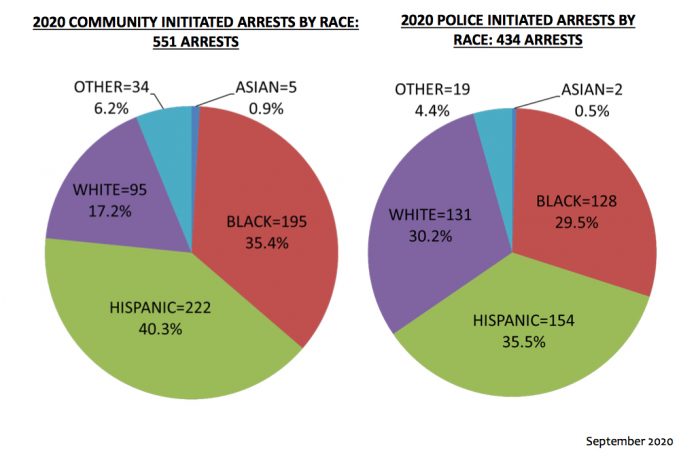
In a continued effort to demonstrate transparency in the wake of calls for significant police reform in the wake of the killing of George Floyd by a Minneapolis police officer, the Culver City Police Department (CCPD) has added arrest initiation data to its monthly reports. The data is presented in graphs, and shows arrest distributions by race and crime based on whether the arrest was a police initiated incident or a community initiated incident.
Community initiated arrests are defined as ones where police officers are responding to a 911 call, while police initiated arrests are done by police on routine patrol.
According to the reports, the ratio of community to police initiated arrests has flipped over the past two years, with a 51.5% police initiated arrest rate in 2019 but a 44.1% rate in 2020. There was a notably higher rate of community initiated arrests being of black people, which came in at 42.1% (458 of 1088) of community initiated arrests in 2019, as compared to 25.3% (292 of 1153) of police initiated arrests. A similar ratio exists in 2020, but it is not nearly as pronounced, with 35.4% (195 of 551) of community initiated arrests being arrests of black people, while just 29.5% (128 of 434) of police initiated arrests were African American.
Another ratio that flipped was the percentage of Hispanic arrests that were police versus community initiated. 2019 saw 33.2% (361 of 1088) of community initiated arrests targeting Hispanics, while 38% (438 of 1153) of police initiated arrests that year were of Hispanics. That flipped in 2020, where 40.3% (222 of 551) of the community initiated arrests targeted Hispanics, while they only made up 35.5% (154 of 434) of police initiated arrests in 2020.
However, possibly the most interesting and striking difference is the arrests of white people. Only 17.9% (195 of 1088) community initiated arrests were of white people, but they made up for 31.7% (365 of 1153) of police initiated arrests. This difference held true in 2020, with 17.2% (95 of 551) community initiated arrests being of white people, and 30.2% (131 of 434) of police initiated arrests of the same.
Crime demographics based on arrest initiation were also interesting in that they were almost entirely separate. While there were some small overlaps, such as DUI arrests, ID theft, and warrant arrests, the majority of categories are different.
Police initiated arrests were dominated by narcotics cases, accounting for 46% (728 of 1597) of these arrests in 2019 and 2020, while arrests for drivers who are unlicensed or have an expired license making up 12.6% (200 of 1597) of these arrests. A category of ‘other’ crimes, which include grand theft auto, forgery, receiving stolen property, and vandalism, accounted for 14.3% (227 of 1597) of community initiated arrests
On the other hand, a big chunk of the community initiated arrests — 34.5% (561 of 1639) of them — are related to theft, both grand and petty. The rest of the crimes are generally evenly distributed, with seven other specific crimes falling from 5.3% (86 of 1639) to 8.7% (141 of 1639) of the arrests. Those seven crimes are: DUI, ID theft, public intoxication, arrest warrants, burglaries, robberies, and assault/battery.
‘Other crimes,’ which in this case includes violation of restraining orders, disturbing the peace, vehicle tampering, hit and run, and animal cruelty, make up 12.7% (207 of 1639) of the crimes.












